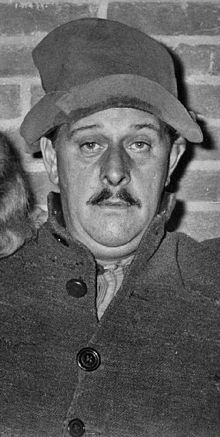| Swiebertje | |
|---|---|
 | |
| First appearance | 1936 |
| Created by | John Henri uit den Bogaard |
| Portrayed by | Joop Doderer |
| In-universe information | |
| Gender | Male |
| Nationality | Dutch |
Swiebertje is a character from the books of Dutch author John Henri uit den Bogaard, who wrote a series of children's books based on the character from 1936 to 1974. The books were adapted for television (Joop Doderer playing the title role), in a series of shows which aired on NCRV in the 1960s and 1970s, one of the longest-running and most popular shows in Dutch TV history.
Character and adventures
The character Swiebertje is a tramp, and is supposed to be inspired by a drawing by Tjeerd Bottema. He is a "lovable vagabond", and his character as well as the TV show "present a comforting image of a simple rural past". His wanderings, during which he typically got in trouble but always found a happy ending, evoked romanticism and adventure. The "innocent" show was the second-most popular show among Dutch children in 1966; the most popular was the more adult program Bonanza.
Regular characters included, besides Swiebertje, the police officer Bromsnor (Lou Geels), housekeeper Saartje (Riek Schagen), and shopkeeper Malle Pietje (Piet Ekel). The vagabond 'Swiebertje' as well as the old-fashioned constable 'Bromsnor' and rag-and-bone man 'Malle Pietje' have grown to become household eponyms in the Dutch language.
Joop Doderer
On TV, he was played by Joop Doderer, who became so identified with the part that the Dutch expression for the most extreme form of typecasting, where an actor is identified with just one single character, is called the Swiebertje-effect. Oudewater has a Swiebertje statue. Doderer played Swiebertje for seventeen years and grew to dislike the character. After the show had run its course, in 1975, he was unable to find serious roles because he was so much identified with Swiebertje; he left for England, where playing roles in high-quality television drama proved a relief. He returned to the Netherlands, and to the stage, and later made peace with the character, saying that Swiebertje derived its popularity from his everyman-qualities.
Adaptations
The TV series was adapted into a comic strip by Gerrit Stapel.
References
- Lechner, Frank J. (2012). The Netherlands: Globalization and National Identity. Routledge. p. 221. ISBN 9781135907709.
- Geelen, R. (2012). Praktijkboek Dementiezorg (in Dutch). Bohn Stafleu van Loghum. p. 302. ISBN 9789031385683.
- Noordman, Joannes Maria Antonius; Rietveld-van Wingerden, Marjoke; Bakker, Petronella Catharina Maria (2010). "Opvoeding en zorg in 'de eeuw van het kind'". Vijf eeuwen opvoeden in Nederland (in Dutch). Van Gorcum. p. 344. ISBN 9789023246138.
- Oosterwijk, Mariët (20 July 2008). "'Malle Pietje' haalt herinneringen aan Swiebertje op". De Telegraaf (in Dutch). Retrieved 20 October 2013.
- ANWB Reisgids NL, Utrecht (in Dutch). Royal Dutch Touring Club. 2006. p. 97. ISBN 9789018023102.
- Ockhuysen, Ronald (23 September 2005). "Swiebertje was een man van iedereen". de Volkskrant (in Dutch). Retrieved 19 October 2013.
- "Gerrit Stapel". Lambiek.net. Retrieved 24 April 2021.
External links
- Swiebertje at IMDb
- Literary characters introduced in 1936
- 1950s in Dutch television
- 1955 Dutch television series debuts
- 1975 Dutch television series endings
- Dutch children's television series
- Television characters
- Fictional Dutch people
- Male characters in literature
- Male characters in television
- Dutch-language television shows
- Fictional hoboes
- Television shows based on Dutch novels
- Television shows set in the Netherlands
- Black-and-white Dutch television shows
- Television shows adapted into comics